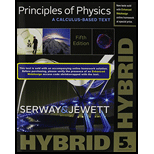
Concept explainers
(a)
The number of loops in the pattern
(a)
Answer to Problem 28P
The pattern exhibits a total of
Explanation of Solution
Write the expression for the wave function of a standing wave.
Here,
Write the given equation for the wave function of standing waves
Compare equation (I) and equation (II) to find the value of wave number.
Write the equation for the wave number.
Here,
Compare equation (I) and equation (II) to find the value of the angular frequency
Write the expression for the angular frequency.
Here,
Conclusion:
The distance between two adjacent nodes is half the wavelength of the standing wave. Write the equation for the distance between two adjacent nodes.
Substitute
The number of loops is the ration between the length of the wire and the distance between the two adjacent nodes. Write the equation for the number of loops.
Here,
Therefore, the pattern exhibits a total of
(b)
The fundamental frequency of vibration
(b)
Answer to Problem 28P
The fundamental frequency of vibration of the wire is
Explanation of Solution
Refer SUB-PART (a)
Conclusion:
Write the equation for the speed of the wave.
Here,
Substitute
The simplest standing wave has the distance of the wire as the distance between the adjacent nodes as they have only two nodes, one at each end.
Also, the distance between the nodes at this case is half the wavelength of the simplest standing wave.
Here,
Write the expression for the frequency of the simplest standing wave in this case.
Substitute
(c)
The number of loops in the new pattern
(c)
Answer to Problem 28P
The new pattern has
Explanation of Solution
Write the equation for the velocity in terms of the tension on the string.
Here,
Write the equation for the tension on the string when the tension is increased by
Here,
Write the new equation for the speed of the wave when the tension is increased.
Conclusion:
Substitute equation (XI) in equation (XII).
Substitute
Write the equation for the wavelength of the wave when the tension on the string is increased.
Here,
The distance between the nodes at this case is half the wavelength of the standing wave.
Substitute
Therefore, the distance between two adjacent nodes when the tension is increased is
Want to see more full solutions like this?
Chapter 14 Solutions
Principles of Physics: A Calculus-Based Text, Hybrid (with Enhanced WebAssign Printed Access Card)
- Hi! I need help with these calculations for part i and part k for a physics Diffraction Lab. We used a slit width 0.4 mm to measure our pattern.arrow_forwardExamine the data and % error values in Data Table 3 where the angular displacement of the simple pendulum decreased but the mass of the pendulum bob and the length of the pendulum remained constant. Describe whether or not your data shows that the period of the pendulum depends on the angular displacement of the pendulum bob, to within a reasonable percent error.arrow_forwardIn addition to the anyalysis of the graph, show mathematically that the slope of that line is 2π/√g . Using the slope of your line calculate the value of g and compare it to 9.8.arrow_forward
- An object is placed 24.1 cm to the left of a diverging lens (f = -6.51 cm). A concave mirror (f= 14.8 cm) is placed 30.2 cm to the right of the lens to form an image of the first image formed by the lens. Find the final image distance, measured relative to the mirror. (b) Is the final image real or virtual? (c) Is the final image upright or inverted with respect to the original object?arrow_forwardConcept Simulation 26.4 provides the option of exploring the ray diagram that applies to this problem. The distance between an object and its image formed by a diverging lens is 5.90 cm. The focal length of the lens is -2.60 cm. Find (a) the image distance and (b) the object distance.arrow_forwardPls help ASAParrow_forward
 Physics for Scientists and Engineers: Foundations...PhysicsISBN:9781133939146Author:Katz, Debora M.Publisher:Cengage Learning
Physics for Scientists and Engineers: Foundations...PhysicsISBN:9781133939146Author:Katz, Debora M.Publisher:Cengage Learning University Physics Volume 1PhysicsISBN:9781938168277Author:William Moebs, Samuel J. Ling, Jeff SannyPublisher:OpenStax - Rice University
University Physics Volume 1PhysicsISBN:9781938168277Author:William Moebs, Samuel J. Ling, Jeff SannyPublisher:OpenStax - Rice University Principles of Physics: A Calculus-Based TextPhysicsISBN:9781133104261Author:Raymond A. Serway, John W. JewettPublisher:Cengage Learning
Principles of Physics: A Calculus-Based TextPhysicsISBN:9781133104261Author:Raymond A. Serway, John W. JewettPublisher:Cengage Learning Classical Dynamics of Particles and SystemsPhysicsISBN:9780534408961Author:Stephen T. Thornton, Jerry B. MarionPublisher:Cengage Learning
Classical Dynamics of Particles and SystemsPhysicsISBN:9780534408961Author:Stephen T. Thornton, Jerry B. MarionPublisher:Cengage Learning Glencoe Physics: Principles and Problems, Student...PhysicsISBN:9780078807213Author:Paul W. ZitzewitzPublisher:Glencoe/McGraw-Hill
Glencoe Physics: Principles and Problems, Student...PhysicsISBN:9780078807213Author:Paul W. ZitzewitzPublisher:Glencoe/McGraw-Hill Physics for Scientists and EngineersPhysicsISBN:9781337553278Author:Raymond A. Serway, John W. JewettPublisher:Cengage Learning
Physics for Scientists and EngineersPhysicsISBN:9781337553278Author:Raymond A. Serway, John W. JewettPublisher:Cengage Learning





